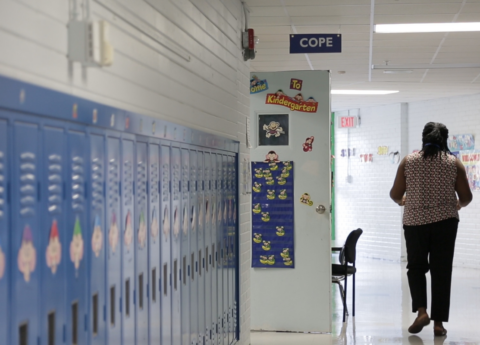All Kentucky children – living in poor and wealthy districts, black, brown and white, whose parents didn’t finish high school and that have advanced degrees – deserve a high-quality education that will equip them to contribute fully to their community and the state’s economy. The most efficient and effective way to invest state tax dollars toward that end is to adequately and equitably fund the state’s public schools.
But House Bill 350 (HB 350) and its companion bill in the Senate (SB 110) would siphon a large and growing amount of public resources through a tax break for donors to private schools, deepening the fiscal strain public schools are experiencing after a decade of state budget cuts.
Compared to previous versions of the proposal, this year’s bills are largely similar yet even more expensive, with a cost that could total as much as $1 billion over just 11 years. By providing no sunset date or ultimate cap on the program, costs would continue to grow over time, consuming an increasing share of resources that would otherwise be invested in public services through the state budget.
Rich tax break will be very costly for state and harm public schools
Direct public spending on private schools through vouchers is prohibited by Kentucky’s constitution. Accomplishing the same purpose through the tax code instead with an almost 100 percent tax credit seemingly circumvents this prohibition, which is why these programs, currently existing in 18 other states, are also called “back door vouchers” or “neo-vouchers.”
For donors of cash and marketable securities to private school scholarship granting organizations (SGOs), the proposed program would carve out a large tax break against individual, limited liability, corporate and bank franchise taxes. At 95 cents for every dollar of donations up to $1 million – increasing to 97 cents for multi-year donations – this incredibly rich tax break is 19 times bigger than the state’s charitable deduction for other kinds of giving, and would be the most generous tax credit offered in Kentucky. And it allows donors with less tax liability than tax credit to carry forward the unused portion for up to 5 years.
The cost of the tax break is capped at $25 million in the first year, and if 90 percent of that amount is utilized, the cap will grow by 25 percent the following year. It is very likely the full cap will be used because “donors” can ensure an almost complete return of the amount contributed due to the generosity of the credit. In addition, some donors may be able to even turn a profit from giving (described below). This large payback allows the individuals, businesses and financial institutions making the contributions to directly transfer public resources to private education at nearly no cost to themselves, or even to potential personal financial gain. A similarly-designed program in Florida is evidence that the fiscal impact of HB 350 would rapidly grow, putting extreme fiscal strain on the state budget and on state funding for public education.
While last year’s bill would have limited the overall General Fund impact to a still-unaffordable $209 million over the 6-year course of the tax credit, HB 350’s unrestricted time-frame could cost as much as $831 million over 10 years with the potential to scale up to a cumulative $8.6 billion over 20 years – and more thereafter.
Public resources will subsidize tuition for relatively well-off families
Though proponents suggest these tax breaks are a way to provide a private school option to families who would otherwise not be able to afford it, the proposal insufficiently targets low- or even moderate-income families.
- Income eligibility for the scholarship is up to 200 percent of household income necessary for reduced-price meals. Reduced price meal eligibility is 185 percent of the federal poverty line (FPL) based on family size.
- For a family of four, multiplying the FPL of $25,750 by 185 percent, and then by 200 percent yields $95,275.
- That’s so generous a limit that 71% of Kentucky children age 18 and under would qualify.
Last year we debunked the national “EdChoice” advocates’ claim that a private school tax credit would save Kentucky money. The generous income eligibility criteria described above does not just undermine the stated purpose of providing private school access to families that otherwise couldn’t afford tuition, but it is also is a reason why proponents’ claim that the program would result in savings falls apart under scrutiny.
With the ability of students from relatively well-off families to participate, and with no requirement that recipients previously attend public schools, many families already paying or planning to pay for private schools would benefit from the scholarships. That means less resources for public schools without an equivalent reduction in the number of students public schools are responsible for educating. Testimony at the March 5, 2019 House Appropriations and Revenue Committee on last year’s bill came from parents who already had children in private school without the aid of a tax credit scholarship program.
Compared to last year’s proposal, HB 350 also worsens the cost impact by increasing the share of first-time scholarships that can go to relatively well-off families who are more likely to send their kids to private schools even without the scholarship. The 2019 bill stipulated that the share of awards going to low-income, foster and students with special needs must equal 90% of the statewide share of students eligible for reduced price meals (which was 73% in 2019, for a total of 66%). Under HB 350, simply a majority (>50%) of first-time recipients must be in this targeted group.
Worse still, because of the way the proposal gives scholarship priority to past recipients and their siblings regardless of family incomes (which tend to grow), over time, better-off beneficiaries are likely to crowd out lower-income applicants. In other words, after year one of the program, scholarships are awarded first to students who received one the previous year and their siblings. Only if any money is left over does a share (>50%) go to students in need.
For those children who do leave public school to attend private school through the program, Kentucky educators and administrators testified at the same hearing in 2019 that limited savings resulting from having fewer students to educate would not offset the losses in state revenue; When enrollment declines, schools’ fixed and stranded costs remain the same. The bill will reduce General Fund resources overall, and reduce state payments to districts when enrollment declines.
Research supports cost concerns
Neovoucher advocates’ claim that public schools will come out ahead financially is supported almost exclusively by analyses done by Martin Lueken of Ed Choice, a national group in favor of private school tax breaks. In fact, last year Kentucky advocates of the bill shared a “fiscal impact statement” written by Lueken and crafted to look much like the LRC’s fiscal notes.
Lueken’s analysis is based on the idea that scholarships to private schools cost less per pupil than a public education, and looks at existing programs in other states to back up these claims. However, a closer examination by the National Education Policy Center at the University of Colorado reveals these claims are unsubstantiated based on problems related to whether students actually leave public for private schools and, in the cases that they do, whether districts are able to reduce their costs enough:
- Hypothetical savings could only occur when students leave public schools to attend private schools. Lueken’s analysis assumes that 90% of Kentucky participants would switch from public to private schools but as described above, the program is insufficiently targeted to students who otherwise wouldn’t be able to afford tuition. Programs in other states that do not target low-income public school students end up instead serving families with kids already enrolled in private schools.
- When a student does switch from a public to a private school and the public school loses its state allotment for that student, the public school may be able to reduce spending on certain variable costs related to the individual student (obviously, fixed costs on things like facilities, maintenance and debt service don’t go down). Lueken asserts these variable costs are reduced by more than state funding goes down without listing or explaining variable costs that are associated with individual student enrollment. Even if a high number of students were to switch, they would likely be disbursed across different schools and grades, making it much less likely that a district would be able to sufficiently reduce overall costs.
What this all means is that HB 350 will cost our public P-12 classrooms in two ways: schools are likely to lose more state funding than their costs are reduced when students switch from public to private schools, even while a large amount of tax revenue for public school funding will no longer be available because the program pays for the tuition of children who are already attending private school.
Program still allows “donors” to profit
As mentioned previously, the proposal would provide a credit of 95 or 97 cents for every dollar donated. By stacking their federal charitable deduction on top of the state credit, donors could recoup between 97% and 100% of their donation. As with previous private school tax credit proposals, HB 350 would also allow donors to make money from redirecting public resources to private schools. This would occur if they donate stocks and – in addition to the dollar for dollar credit – avoid capital gains taxes on the stock’s appreciated value.
HB 350 would create the richest tax break in Kentucky’s tax system, rewarding donors to private schools far beyond the charitable deduction for donations to churches and synagogues, domestic violence shelters, hospital charities, Habitat for Humanity, Girls’ and Boys’ Clubs and humane societies. It will greatly diminish the limited resources the state has to uphold its duty to efficiently provide an equal and high-quality education to all Kentucky kids.




